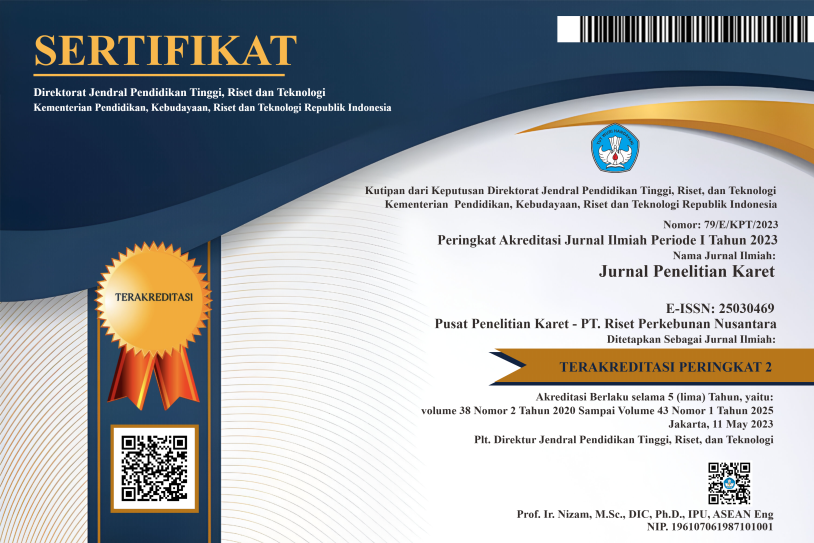PRODUKSI KARET DAN KONDISI FISIOLOGIS LATEKS KLON GT 1 PADA BERBAGAI UMUR DAUN DAN CURAH HUJAN
DOI:
https://doi.org/10.22302/ppk.jpk.v41i2.833Keywords:
Hevea brasiliensis, jumlah curah hujan, kualitas lateks, umur daunAbstract
Faktor genotipe, lingkungan, dan interaksi genotipe dengan lingkungan memengaruhi perkembangan dan kemampuan menghasilkan lateks yang tinggi. Salah satu faktor dominan adalah kondisi lingkungan yaitu curah hujan bulanan dan sistem eksploitasi yang memengaruhi hasil lateks klon GT 1. Penelitian ini bertujuan untuk mengetahui hubungan yang erat antara beberapa variable fisiologi lateks, umur daun, dan hasil lateks klon GT 1. Hasil penelitian menyimpulkan bahwa fisiologi lateks berfluktuasi yang dipengaruhi oleh umur daun dan kadar air tanah (curah hujan). Perkembangan daun memengaruhi kondisi fisiologis lateks. Pada kondisi daun masih berwarna coklat-hijau cenderung fisiologis lateks rendah dan diduga distribusi fotosintat lebih banyak dialokasikan untuk perkembangan daun. Aktivitas fisiologi lateks mulai meningkat kembali pada saat daun berwarna hijau muda.
References
Atminingsih. (2015). Respon fisiologi lateks dan histologi pembuluh lateks beberapa klon terhadap konsentrasi stimulan yang berbeda pada tanaman karet (Hevea brasiliensis Muell Arg) (tesis), Universitas Sumatera Utara, Indonesia.
Bricard, P., & Nicolas, D. (1989). Possibility of the use of physiologica parameters of latex in early selection. In J. d'Auzac, J. L. Jacob, & Chrestin. (Ed.) H. Physiology of Rubber Tree. France: Imprint CRC Press.
ische, Z. M. (1962). Carbohydrate Chemistry Vol 1. New York, US: Acad Press.
Fatma, D. (2017, 27 Oktober). 5 Kategori klasifikasi iklim oldeman. Diakses dari https://ilmugeografi.com/ilmu-bumi/meteorologi/klasifikasi-iklim-oldeman
Gomez, J., Hilser, V. J., Xie, D., & Freire, E. (1995). The heat capacity of proteins. Proteins: Structure, Function, and Bioinformatics, 22(4): 404-412.
Gunasekara, H. K. I. K., de Costa, W. A. J. M., & Nugawela, E. A. (2007). Genotypic variation in canopy photosynthesis, leaf gas exchange characteristics and their response to tapping in rubber (Hevea brasiliensis). Experimental Agriculture, 43: 223-239.
Jacob, J. L., Prevot, J. C., & Kekwick, R. G. O. (1989). General metabolism Hevea brasiliensis latex. In J. d'Auzac, Jacob, & H. Chertis (Ed.). Physiology of rubber tree latex. Florida, US: CRC Press.
Junaidi, & Atminingsih. (2017). Perkembangan ontogenetik daun tanaman karet sebagai penanda awal adaptasi terhadap cekaman lingkungan dan patogen. Warta Perkaretan, 36(1): 29-38.
Kuswanhadi, Sumarmadji, Karyudi, & Siregar, T. H. S. 2009. Optimasi produksi klon karet melalui sistem eksploitasi berdasarkan metabolisme lateks. Prosiding Lokakarya Nasional Pemuliaan Tanaman. Batam: Pusat Penelitian Karet.
Lacote, R. (2007). Some considerations concerning the yield potential of some clones. Proceedings of International Rubber COnference 2007. Siem Reap, Cambodia: IRRDB and CRRI.
Lasminingsih, M. (2010). Rekomendasi klon karet periode 2010-2014. Seri Leaflet No: 01/Klon/LF/2010. Palembang, Indonesia: Balai Penelitian Sembawa.
Matondang, C. O, & Nurhayati. (2022). Pengaruh cekaman air terhadap pertumbuhan dan produksi tanaman kopi. Best Journal, 5(1): 249-254.
Mattos, D., Quaggio, J. A., Cantarella, H., & Alva, A. K. (2003). Nutrient content of biomass components of Hamlin sweet orange trees. Sci Agric, 60: 155-160.
McMullen, A. I. (1960). Tiols of low molecular weight in Hevea basiliensis latex. Biochem. Biophy. Acta, 41: 152-154.
Mirabello, M. J., Yavitt, J. B., Garcia, M., Harms, K. E., Turner, B. L., & Wright, S. J. (2013). Soil phosphorus responses to chronic nutrient fertilisation and seasonal drougth in a humid lowland forest in Panama. J Soil Res, 51: 215-221.
Nair, N. U., Nair, B. R., Thomas, M., & Gopalakrishan, J. (2004). Latex diagnosis in relation to exploitation system in clone slow starter 105. J Indian Rub Res, 7(2): 127-137.
Nugawela, A., & Aluthhewage, R. K. (1990). The effect of tapping on the CO2 assimilation rates of Hevea brasiliensis Muell. Arg. leaves. Journal Rubber Research Institute of Sri Lanka, 70: 45-51.
Priyadarshan P. M., Hoa, T. T. T., Huasun, H., Gonçalves, P. de S. (2005). Yielding potential of rubber (Hevea brasiliensis) in sub-optimal environments. Journal of Crop Improvement, 14(1): 221-247. doi: 10.1300/J411v14n01_10
Priyadarshan, P. M. (2003). Breeding Hevea brasiliensis for environmental constraints. Advances in Agronomy, 79: 351-400. doi: 10.1016/S0065-2113(02)79007-X.
Priyadarshan, P. M., Sasikumar, S., & Goncalves, P. D. S. (2001). Phenological change in Hevea brasiliensis under differential geo-climates. The Planter, 77: 447 – 459.
Purwaningrum, Y., & Asbur, Y. (2019). Karakter fisiologi lateks dan hubungannya dengan produksi lateks klon GT 1 di kebun karet rakyat Kabupaten Langkat. J. Nat. Rubb. Res.,37(1): 21-30.
Rusli, & Ferry, Y. (2014). Model peremajaan karet rakyat dan implikasinya. Warta Penelitian dan Pengembangan Tanaman Industri, 2(3): 13–17.
Sanz, A., Monerri, C., González?Ferrer, J., & Guardiola, J. L. (1987). Changes in carbohydrates and mineral elements in citrus leaves during flowering and fruit set. Physiologia Plantarum, 69(1): 93-98.
Schartner, J., Gavriljuk, K., Nabers, A., Weide, P., Muhler, M., Gerwert, K., & Kötting, C. (2014). Immobilization of proteins in their physiological active state at functionalized tiol monolayers on ATR-germanium crystals. ChemBioChem, 15(17): 2529-2534.
Silpi, U., Chantuma, P., Kasemsap, P., Thaler, P., Thanisawanyangkura, S., Lacointe, A., Ameglio, T., & Gohet, E. (2006). Sucrose and metabolism distribution patterns in the laticiferes of three Hevea brasiliensis clones: effect of tapping and stimulation on the tree trunk. Journal of Rubber Research, 9(2): 117.
Siregar, T. H. S. (2008). Dinamika kerontokan daun pohon karet (Hevea brasiliensis Muell Arg.) dan hasil lateks (disertasi), Universitas Gadjah Mada, Indonesia.
Sumarmadji, Karyudi, & Siregar, T. H. S. (2006). Rekomendasi sistem eksploitasi pada klon quick starter dan slow starter serta pengggunaan irisan ganda untuk meningkatkan produktivitas tanaman karet. Prosiding Lokakarya Nasional Budidaya Tanaman Karet 2006. Medan: Balai Penelitian Sungei Putih, Pusat Penelitian Karet.
Sumarmadji, & Tistama, R. (2004). Deskripsi klon karet berdasarkan karakter fisiologi lateks untuk menetapkan sistem eksploitasi yang sesuai. Jurnal Penelitian Karet, 22(1): 27-40.
Sumarmadji, Siswanto, & Yahya, S. (2004). Penggunaan parameter fisiologi lateks untuk penentuan sistem eksploitasi tanaman karet. J. Penelitian Karet, 22(1): 41-52.
Taussky, H. H., & Shorr, E. (1953). A micro colorimetric methods for the determination of inorganic phosphorus. Journal of Biology Chemistry, 202: 675-685.
Tistama, R. (2013). Peran seluler etilen eksogen terhadap peningkatan produksi lateks pada tanaman karet (Hevea brasiliensis). Warta Perkaretan, 32(1): 45-57.
Tistama, R., Lubis, V., & Nurwahyuni, I. (2017). Perubahan histologi dan fisiologi latisifer pada tanaman karet (Hevea brasiliensis Muell Arg.) yang diberi asam jasmonat dan asam naftalen asetat eksogen. Buletin Anatomi dan Fisiologi, 2(1): 1-10. doi: 10.14710/baf.2.1.2017.1-10.
Vinod, K. K., Suryakumar, M., Chandrasekhar, T. R., & Nazeer, M. A. (2010). Temporal stability of growth and yield among Hevea genotypes introduced to a non-traditional rubber growing region of peninsular India. Annals of Forest Research, 53(2): 107-115
Woelan, S., Sayurandi, S., & Pasaribu, S. A. (2013). Karakter fisiologi, anatomi, pertumbuhan dan hasil lateks klon IRR Seri 300. Jurnal Penelitian Karet, 31(1): 1-12.
Zambrosi, F. C. B., Fernando, C., Zambrosi, B., Mattos, D., Rodrigo, Boaretto, M., Quaggio, J. A., Muraoka, T., & Syvertsen, J. P. (2012). Contribution of phosphorus (32P) absorption and remobilization for citrus growth. J Plant Soil, 255: 353-362.
Downloads
Published
How to Cite
Issue
Section
License
Copyright (c) 2023 Yayuk Purwaningrum, Yenni ASBUR

This work is licensed under a Creative Commons Attribution-ShareAlike 4.0 International License.
Submission of a original research article in Jurnal Penelitian Karet implies that the submitted  manuscript has not been published in any scientific journal (except being part of the abstract, thesis, or report). The submitted manuscript also is not under consideration for publication elsewhere. All co-authors involve in the publication of the manuscript should give their approval.
Once, the manuscript is accepted and then published in Jurnal penelitian Karet, the Author(s) keep hold the copyright and retain publishing right without restrictions.
Author(s) and Jurnal Penelitian Karet users are allowed to multiply the published manuscript. The journal users are also permissible to share the published manuscript with an acknowledgement to the Author(s). The Editorial Boards suggest that the Authors should manage patent before publishing their new inventions.
















